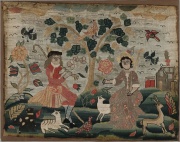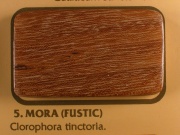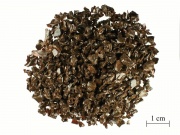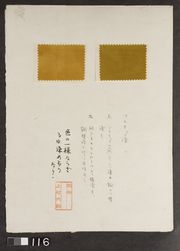Difference between revisions of "Fustic"
(username removed) |
|||
| (12 intermediate revisions by 3 users not shown) | |||
| Line 1: | Line 1: | ||
| + | [[File:MFA 44.750.jpg|thumb|Embroidered picture<br>MFA# 44.750]] | ||
| + | == Description == | ||
[[File:mora ewc.jpg|thumb|Mora (''Chlorophora tinctoria'')]] | [[File:mora ewc.jpg|thumb|Mora (''Chlorophora tinctoria'')]] | ||
| − | + | A natural, yellow dyestuff produced from a boiling water extract of wood chips from the dyer's mulberry, ''Chlorophora tinctoria'' or ''Maclura tinctoria'', trees. Commonly know as 'old fustic', the dye was imported into Europe in 1510 from the West Indies, South America and Central America. Dye colors can range from a pale yellow with [[alum]] to a dark tan with [[copper]]. Soaking the wood for long periods produces a stronger color. Fustic contains the yellow flavonol colorant [[morin]]. Morin will react with [[aluminum]] to produce a green fluorescent compound. Fustic produces a slowly fugitive, bright yellow coloring that is used as a [[textile]] and [[leather]] dye, [[stain|wood stain]], a [[varnish]] colorant and a [[lake]] pigment. It is often mordanted with chromium salts. | |
| − | + | (This is not the same dye as [[young fustic]].) | |
| − | + | * See also [[https://cameo.mfa.org/wiki/Category:Uemura_dye_archive '''Uemera Dye Archive''' (Fustic and Ouboku)]] Reference Collection | |
| − | + | * Fustic was found in textiles in the [[https://cameo.mfa.org/wiki/Category:Dye_Analysis '''Dye Analysis''']] Reference Collection | |
| + | == Synonyms and Related Terms == | ||
[[File:fustic_ground_1.jpg|thumb|Fustic pieces]] | [[File:fustic_ground_1.jpg|thumb|Fustic pieces]] | ||
| − | |||
| − | |||
''Chlorophora tinctoria'' (formerly ''Morus tinctoria''); ''Maclura tinctoria;'' Natural Yellow 11; CI 75240; bois jaune (Fr.); Gelholz (Deut.); fustic (Esp.); gaud (It.); madera amilla de Cuba (Esp.); geelhout (Ned.); aurantica; aurantine; carmin de Cuba; Cubawood; yellowwood; old fustic; fustik; yellow wood; Cuba wood; dyer's mulberry; mora | ''Chlorophora tinctoria'' (formerly ''Morus tinctoria''); ''Maclura tinctoria;'' Natural Yellow 11; CI 75240; bois jaune (Fr.); Gelholz (Deut.); fustic (Esp.); gaud (It.); madera amilla de Cuba (Esp.); geelhout (Ned.); aurantica; aurantine; carmin de Cuba; Cubawood; yellowwood; old fustic; fustik; yellow wood; Cuba wood; dyer's mulberry; mora | ||
| − | == | + | == Physical and Chemical Properties == |
| − | + | [[File:Uemura 05-29-2009 116.jpg|thumb|silk dyed with old fustic<br>Uemera Dye Archives]] | |
Morin is soluble in alkali solutions, hot ethanol and acetic acid. Soluble in sulfuric acid forming a solution with green fluorescence. Slightly soluble in water. | Morin is soluble in alkali solutions, hot ethanol and acetic acid. Soluble in sulfuric acid forming a solution with green fluorescence. Slightly soluble in water. | ||
| − | |||
| − | |||
| − | |||
| − | |||
== Additional Images == | == Additional Images == | ||
| Line 28: | Line 25: | ||
</gallery> | </gallery> | ||
| + | == Resources and Citations == | ||
| − | + | * J. and M. Cannon, ''Dye Plants and Dyeing'', The Herbert Press, London, 1994. | |
| + | * J.Hofenk-de Graaf, ''Natural Dyestuffs: Origin, Chemical Constitution, Identification'', Central Research Laboratory for Objects of Art and Science, Amsterdam, September 1969. | ||
* Helmut Schweppe, Schweppe color collection index and information book | * Helmut Schweppe, Schweppe color collection index and information book | ||
| Line 45: | Line 44: | ||
* John and Margaret Cannon, ''Dye Plants and Dyeing'', Herbert Press, London, 1994 | * John and Margaret Cannon, ''Dye Plants and Dyeing'', Herbert Press, London, 1994 | ||
| − | * ''Encyclopedia Britannica'', http://www.britannica.com Comment: "fustic" | + | * ''Encyclopedia Britannica'', http://www.britannica.com Comment: "fustic" [Accessed October 2, 2001]. |
* Art and Architecture Thesaurus Online, http://www.getty.edu/research/tools/vocabulary/aat/, J. Paul Getty Trust, Los Angeles, 2000 | * Art and Architecture Thesaurus Online, http://www.getty.edu/research/tools/vocabulary/aat/, J. Paul Getty Trust, Los Angeles, 2000 | ||
Latest revision as of 11:58, 22 June 2022
Description
A natural, yellow dyestuff produced from a boiling water extract of wood chips from the dyer's mulberry, Chlorophora tinctoria or Maclura tinctoria, trees. Commonly know as 'old fustic', the dye was imported into Europe in 1510 from the West Indies, South America and Central America. Dye colors can range from a pale yellow with Alum to a dark tan with Copper. Soaking the wood for long periods produces a stronger color. Fustic contains the yellow flavonol colorant Morin. Morin will react with Aluminum to produce a green fluorescent compound. Fustic produces a slowly fugitive, bright yellow coloring that is used as a Textile and Leather dye, wood stain, a Varnish colorant and a Lake pigment. It is often mordanted with chromium salts.
(This is not the same dye as Young fustic.)
- See also [Uemera Dye Archive (Fustic and Ouboku)] Reference Collection
- Fustic was found in textiles in the [Dye Analysis] Reference Collection
Synonyms and Related Terms
Chlorophora tinctoria (formerly Morus tinctoria); Maclura tinctoria; Natural Yellow 11; CI 75240; bois jaune (Fr.); Gelholz (Deut.); fustic (Esp.); gaud (It.); madera amilla de Cuba (Esp.); geelhout (Ned.); aurantica; aurantine; carmin de Cuba; Cubawood; yellowwood; old fustic; fustik; yellow wood; Cuba wood; dyer's mulberry; mora
Physical and Chemical Properties
Morin is soluble in alkali solutions, hot ethanol and acetic acid. Soluble in sulfuric acid forming a solution with green fluorescence. Slightly soluble in water.
Additional Images
Resources and Citations
- J. and M. Cannon, Dye Plants and Dyeing, The Herbert Press, London, 1994.
- J.Hofenk-de Graaf, Natural Dyestuffs: Origin, Chemical Constitution, Identification, Central Research Laboratory for Objects of Art and Science, Amsterdam, September 1969.
- Helmut Schweppe, Schweppe color collection index and information book
- G.S.Brady, Materials Handbook, McGraw-Hill Book Co., New York, 1971 Comment: p. 350
- Ralph Mayer, A Dictionary of Art Terms and Techniques, Harper and Row Publishers, New York, 1969 (also 1945 printing)
- Palmy Weigle, Ancient Dyes for Modern Weavers, Watson-Guptill Publications, New York, 1974
- R.D. Harley, Artists' Pigments c. 1600-1835, Butterworth Scientific, London, 1982
- Matt Roberts, Don Etherington, Bookbinding and the Conservation of Books: a Dictionary of Descriptive Terminology, U.S. Government Printing Office, Washington DC, 1982
- John and Margaret Cannon, Dye Plants and Dyeing, Herbert Press, London, 1994
- Encyclopedia Britannica, http://www.britannica.com Comment: "fustic" [Accessed October 2, 2001].
- Art and Architecture Thesaurus Online, http://www.getty.edu/research/tools/vocabulary/aat/, J. Paul Getty Trust, Los Angeles, 2000
- Thomas B. Brill, Light Its Interaction with Art and Antiquities, Plenum Press, New York City, 1980
- F. Crace-Calvert, Dyeing and Calico Printing, Palmer & Howe, London, 1876
- Colour Index International online at www.colour-index.org
- J. Thornton, 'The Use of Dyes and Colored Varnishes in Wood Polychromy', Painted Wood: History and Conservation, The Getty Conservation Insitute, Los Angeles, 1998







